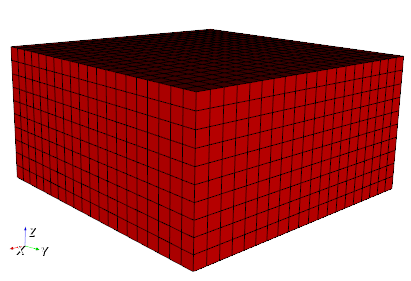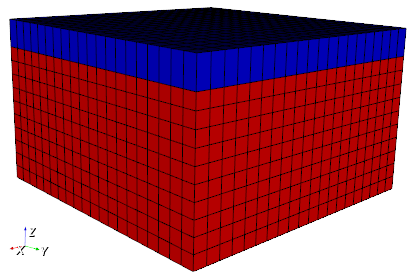AddLayer
Introduction
The tool AddLayer adds one layer of elements with a specified thickness
thickness on either on top or bottom of an existing mesh input-mesh and
returns the newly generated mesh output-mesh that has an new layer.
One might want to take care that the material groups are reduced, e.g. material
groups should not be [0,2,5], but [0,1,2]. The new layer will have the material
group number of the highest material group +1. With the switch
--copy-material-ids the MaterialIDs of the extruded layer will be kept.
The tool requires the OGS-6 node ordering in the elements. A different node ordering may lead to unexpected results. In case one might try to change the ordering using the tool NodeReordering.
Usage
AddLayer -i <input-mesh> -o <output-mesh> [-t <thickness>]Simple example


Usage for example:
AddLayer -i quad.vtu -o quad_with_new_top_layer.vtu -t 1Application
The tool was used to add a “soil” layer to the hydro-geological model of the Unstrut catchment within the INFLUINS project:
Fischer, T. and Naumov, D. and Sattler, S. and Kolditz, O. and Walther, M. (2015): GO2OGS 1.0: a versatile workflow to integrate complex geological information with fault data into numerical simulation models. Geosci. Model Dev., vol. 8, p. 3681--3694, DOI:10.5194/gmd-8-3681-2015 https://www.geosci-model-dev.net/8/3681/2015/gmd-8-3681-2015.pdfThis article was written by Thomas Fischer. If you are missing something or you find an error please let us know.
Generated with Hugo 0.122.0
in CI job 449919
|
Last revision: April 23, 2024
Commit: [PL/LD] Use generic cell average output 3557e29
| Edit this page on